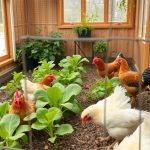If you’re a chicken owner, finding effective and simple ways to keep your flock hydrated is essential. Here are 17 DIY chicken waterer ideas that are not only easy to create but also practical for any backyard setup. From repurposing household items to crafting from scratch, these ideas will help ensure your feathered friends have access to clean water without breaking the bank.
Repurposed Plastic Bottles for Easy Access
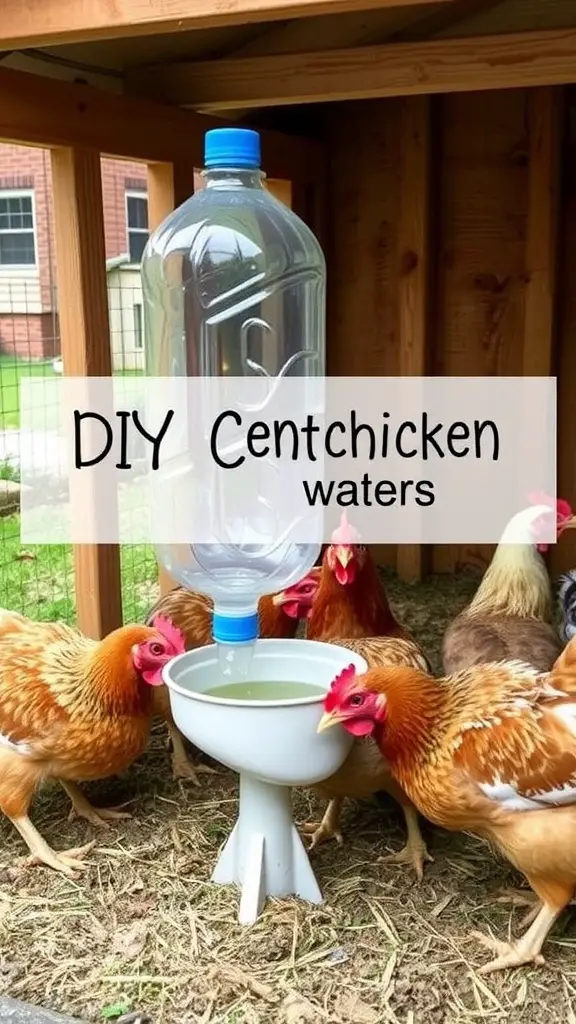
Using repurposed plastic bottles to create a chicken waterer is both simple and practical. In the image, you can see a clear plastic bottle securely fastened above a bowl. This clever setup allows for easy access to fresh water for your chickens.
Chickens need constant access to clean water, and this DIY design does just that. The bottle slowly dispenses water into the bowl below as your birds drink, ensuring they always have what they need. It’s a great way to recycle while also tending to your flock.
To make your own version, grab an empty plastic bottle, a sturdy bowl, and a bit of creativity. Secure the bottle upside down so it can pour water into the bowl. This way, you can keep your chickens hydrated without constant refills.
Water Trough for Larger Flocks
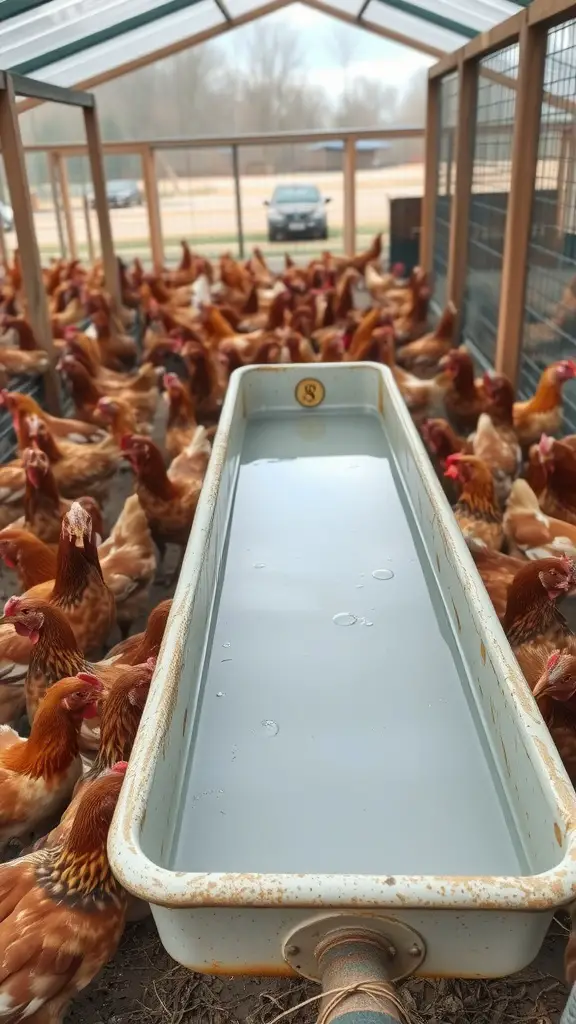
If you have a larger flock of chickens, a water trough can be a simple and effective way to keep them hydrated. In the image above, you can see a long water trough filled with fresh water, designed to serve many chickens at once. This setup not only provides ample space for the birds to drink but also helps reduce the frequency of refills.
Using a trough is a practical solution that can handle the needs of your growing flock. The style shown here is easy to clean and maintain, which is essential for keeping your chickens healthy. Just make sure to regularly check the water level and clean out any debris that may find its way in.
One of the added benefits of a water trough is that it allows your chickens to drink at their own pace. They can gather around the trough without fighting for space, making it a more relaxed environment for them. Plus, it’s a great way to keep an eye on how much water your flock is consuming each day.
Nipple Waterer for Clean Drinking

A nipple waterer is a smart solution for providing chickens with fresh water. This design helps keep the water clean and reduces waste. The image shows a well-constructed nipple waterer surrounded by a flock of curious chickens. You can see how they interact with the setup, pecking at the nipples to drink.
These waterers have a unique feature that prevents spills and keeps the water from getting dirty. This is especially handy if your chickens are in a coop with bedding, as it minimizes the mess. Plus, you won’t need to replace the water as often, saving you time and effort.
To set up a nipple waterer, you’ll need a few materials like a container with a lid, water nipples, and some basic tools. Simply drill holes in the container for the nipples, secure them in place, and fill the container with water. Hang it at a height that’s comfortable for your chickens, and watch them enjoy their clean drinking water.
This method not only ensures your chickens have access to fresh water but also promotes their health and well-being. Healthy chickens are happy chickens!
PVC Pipe Watering System

If you’re looking for a simple and effective way to keep your chickens hydrated, a PVC pipe watering system might be just what you need. This system uses PVC pipes to deliver fresh water directly to your flock.
In the image, you can see the setup in action. Water flows from the PVC pipe into a decorative bowl, which serves as a water source for the chickens. This design not only looks good but also keeps the water clean and accessible.
Building your own PVC waterer is pretty straightforward. You’ll need some basic materials: a few sections of PVC pipe, connectors, and a water source. Cut the pipes to your desired length and attach them using the connectors. Position the outlet above a bowl or trough to let the water flow into it.
This system is handy during hot weather, as it encourages your chickens to drink more water. Plus, it reduces the time you spend refilling water containers. Just make sure to check the flow regularly to keep everything running smoothly!
Repurposed Fountains for Chickens
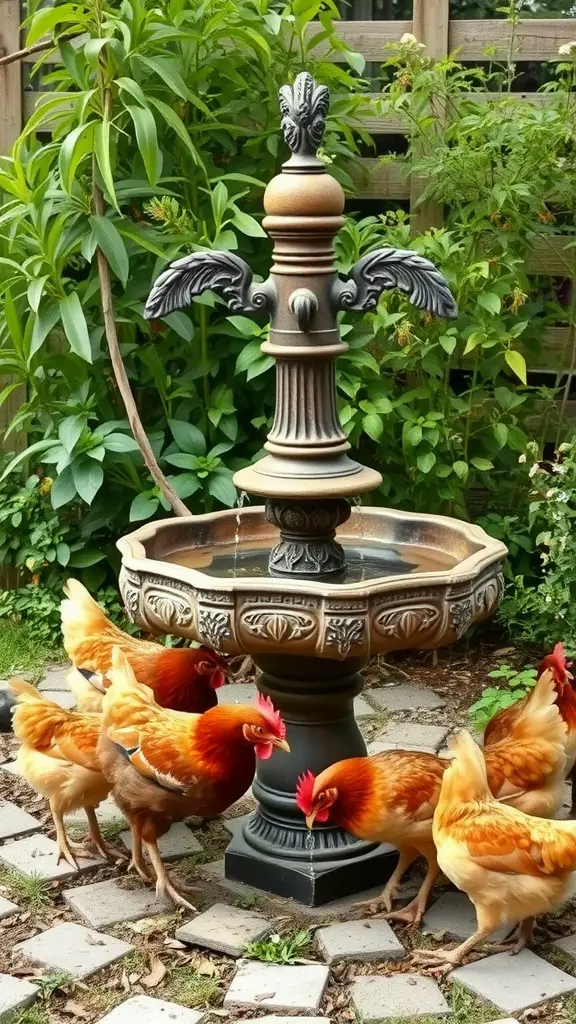
Using a repurposed fountain as a waterer for chickens is a stylish and functional idea. The fountain, with its elegant design, not only serves a practical purpose but also enhances the aesthetic of your backyard or coop area.
Chickens naturally gravitate toward interesting objects, and a fountain can attract them while providing fresh water. The design often allows for easy filling and cleaning, making it a convenient option for chicken owners. Plus, the flowing water keeps the chickens entertained!
Setting up a fountain is simple. Position it in a shaded area to keep the water cool, and ensure it is stable and safe for the chickens to approach. Regular maintenance is key; check for any debris and clean the basin to prevent algae growth.
This approach not only benefits the chickens but can also turn into a beautiful focal point in your garden. So, why not give a fountain a new purpose and keep your flock happy and hydrated?
Wooden Pallet Water Station

Creating a wooden pallet water station for your chickens can be both fun and practical. This design is simple yet effective, providing a large source of fresh water for your feathery friends. The image shows chickens happily drinking from a round, wooden water container, which blends seamlessly with a backyard setting.
The beauty of using a wooden pallet is that it’s often readily available and can be repurposed to fit your gardening needs. You can easily build a sturdy frame and add a water trough or container to hold water. Make sure the container is deep enough to prevent the water from easily tipping over.
Chickens enjoy having space to roam and explore. With a wooden pallet water station, you’re giving them a designated spot to hydrate. This setup not only helps in keeping them hydrated but also encourages them to stay in a safe area instead of wandering off. Plus, it looks nice in your yard!
When constructing this water station, consider adding some shade overhead. Chickens are sensitive to heat, and having a shaded area will help keep the water cooler and more appealing. This design is a great way to keep your chickens healthy and happy.
Hanging Bucket Waterer
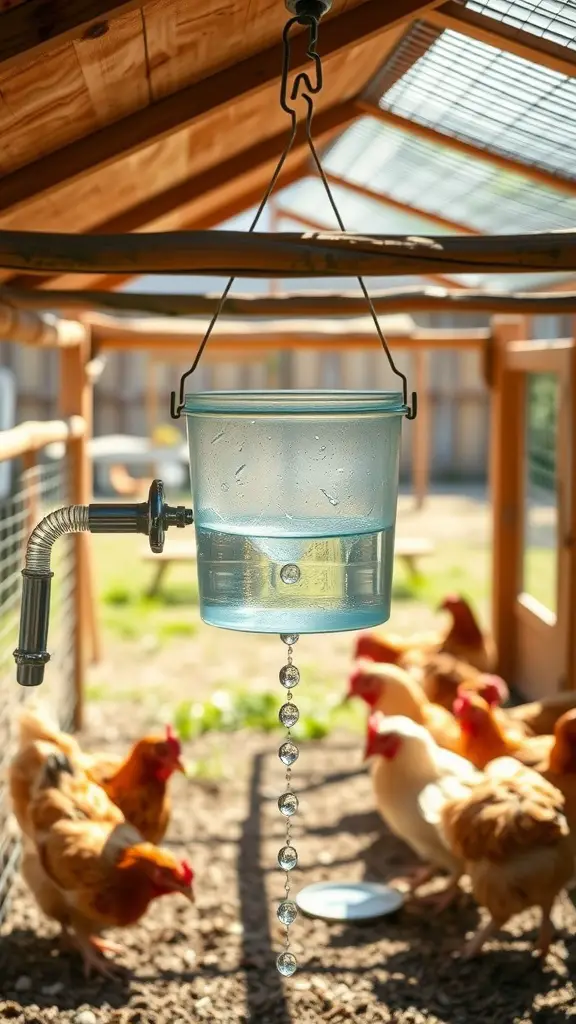
A hanging bucket waterer is a simple and effective way to keep your chickens hydrated. This design uses a bucket suspended from a structure, allowing chickens to drink easily without spilling water everywhere.
The image shows a clear bucket filled with water, hanging securely from a hook. A spout on the side connects to a water line, ensuring a continuous supply. The transparent design lets you quickly see how much water is left, which is super handy for monitoring.
Chickens can peck at the spout to access fresh water, preventing contamination from dirt and debris. This setup is not only practical but also keeps the water cooler, especially on warm days. Plus, it saves you time on refilling, as the bucket holds a good amount.
If you’re into DIY projects, making a hanging bucket waterer can be a fun weekend task. You can gather materials like a bucket, a hook, and some tubing to create your own version. This waterer design is a reliable choice for keeping your flock happy and healthy.
Old Tire Waterer

Using an old tire as a chicken waterer is a clever way to repurpose materials while keeping your flock hydrated. In the image, you can see a group of chickens gathered around a tire that has been transformed into a stylish water source. The design is simple yet functional, allowing the birds easy access to fresh water.
To create your own tire waterer, start by finding a tire that’s no longer in use. Clean it thoroughly to remove any dirt or debris. Next, place a shallow container or bowl inside the tire to hold the water. This setup helps prevent spills and keeps the water clean. Make sure the tire is placed in a shaded area to keep the water cool during hot days.
This DIY project not only helps you save money but also adds a rustic charm to your chicken coop. Chickens are naturally curious and will enjoy drinking from the tire, while you can appreciate the creativity of using something that might otherwise go to waste.
Collapsible Waterer for Travel
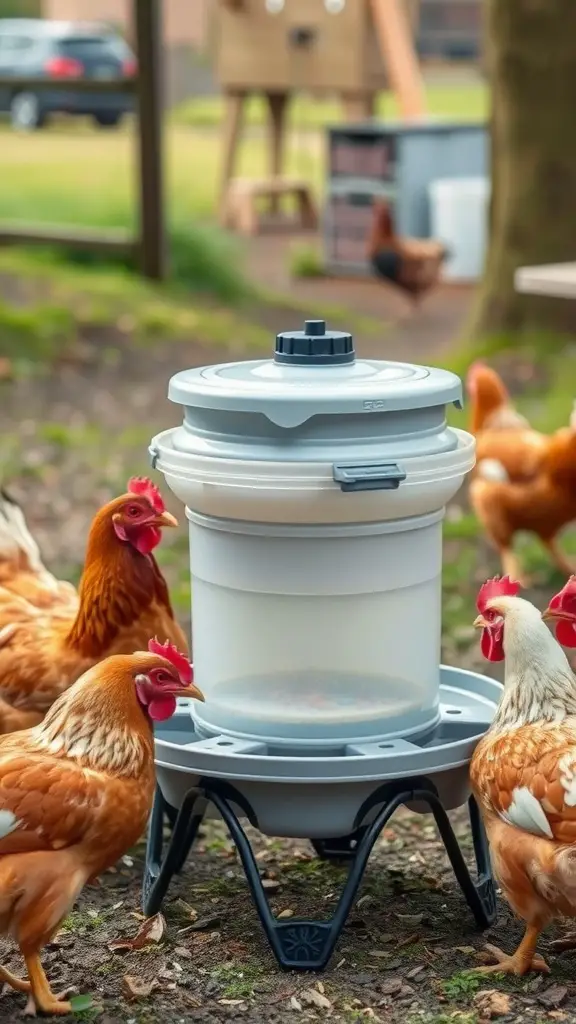
When you’re on the go, keeping your chickens hydrated shouldn’t be a hassle. A collapsible waterer is a simple solution for providing fresh water without taking up much space. This type of waterer is perfect for trips, whether it’s a quick visit to a friend or a longer journey.
The image beautifully illustrates a practical collapsible waterer designed for travel. It features a sturdy, lightweight design that holds enough water for your feathered friends while being easy to carry. The adjustable features let you set it up quickly, so your chickens can have a drink as soon as you arrive at your destination.
Additionally, collapsible waterers are usually made from durable materials that can withstand the rigors of travel. They can be easily cleaned and stored flat, making them a convenient option for any chicken owner who loves to travel.
Next time you plan an outing, consider adding a collapsible waterer to your packing list. It’s a practical way to ensure your chickens stay hydrated, no matter where you are!
Rain Barrel Water Supply
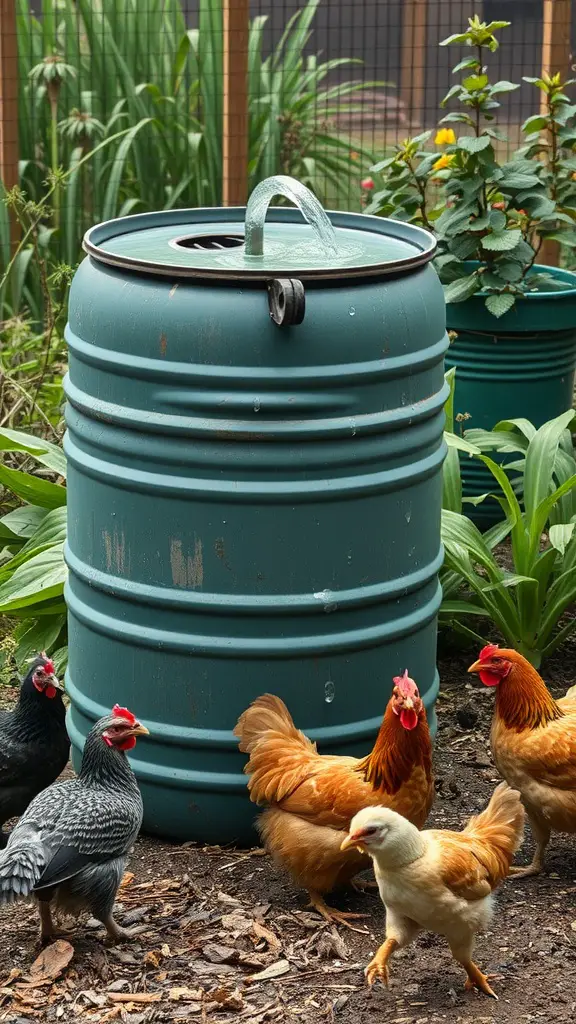
Using a rain barrel as a water supply for your chickens is a smart and eco-friendly idea. In the image, you can see a sturdy barrel designed to collect rainwater, complete with a spout that allows easy access for your feathered friends. This method helps to ensure that your chickens always have a fresh and plentiful water source, especially during those hot summer days.
The beauty of this setup lies in its simplicity. You just need to position the barrel where it can catch rainwater effectively. When it rains, the barrel fills up, providing a sustainable way to keep your chickens hydrated. Plus, it’s a great way to reduce water waste!
Adding a rain barrel to your chicken coop area not only benefits your birds, but it also enhances the overall look of your yard. The green color of the barrel blends nicely with the surrounding plants, creating a natural aesthetic. It’s easy to install, and with a little creativity, you can customize it to fit your space.
Watering Can System for Small Spaces

If you have a small backyard or limited space for your chickens, a watering can system can be a simple yet effective solution. The image shows a charming blue watering can surrounded by various chickens, demonstrating how this method can work in a compact area.
The watering can serves as both a water source and a playful centerpiece for your flock. By filling it with fresh water, you allow the chickens to peck and drink directly from the spout or the main body. This setup not only keeps the water accessible but also helps keep your space tidy.
To create your own watering can system, start with a sturdy, clean watering can. Fill it with fresh water daily, and observe how your chickens interact with it. You might even want to add a small stand to elevate the can, making it easier for the birds to drink without spilling too much water. This method encourages your chickens to stay hydrated while adding a quaint touch to your outdoor area.
Gutter Watering System
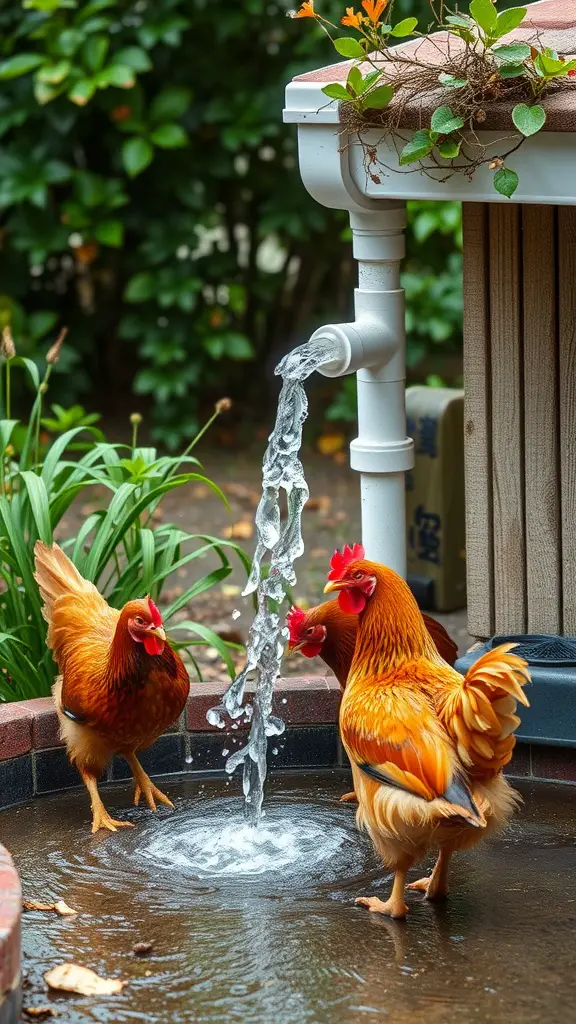
A gutter watering system is a clever way to provide fresh water to your chickens while keeping things tidy. This setup uses a simple gutter attached to a downspout, allowing water to flow directly into a basin where your chickens can drink.
In the image, you can see two chickens enjoying their time near the flowing water. The setup not only looks nice but also offers a continuous supply of clean water. By using materials like PVC pipes and a few connectors, you can create a fun and functional watering system for your flock.
This DIY project is easy to build and can be customized to fit your yard’s layout. You can even add plants or decorations around it to make it more visually appealing. With this gutter watering system, you ensure your chickens always have access to hydration.
Automatic Waterer with Float System

Creating an automatic waterer for your chickens is a smart way to ensure they always have access to fresh water. This particular design features a float system that helps maintain the water level as your birds drink. The float system works similarly to a toilet tank, automatically refilling when the water gets low.
The image showcases a simple yet effective automatic waterer. It has a clear tank to see the water level, which is especially handy for checking on your flock’s hydration. The hose allows for easy access for the chickens, making it a user-friendly design.
Setting up something like this can save you time and effort. You won’t need to refill waterers multiple times a day. Plus, keeping the water clean is easier since the design minimizes contamination from dirt and droppings. If you’re looking for a project that will benefit both you and your chickens, this is definitely worth a try!
Hose Connector Waterer
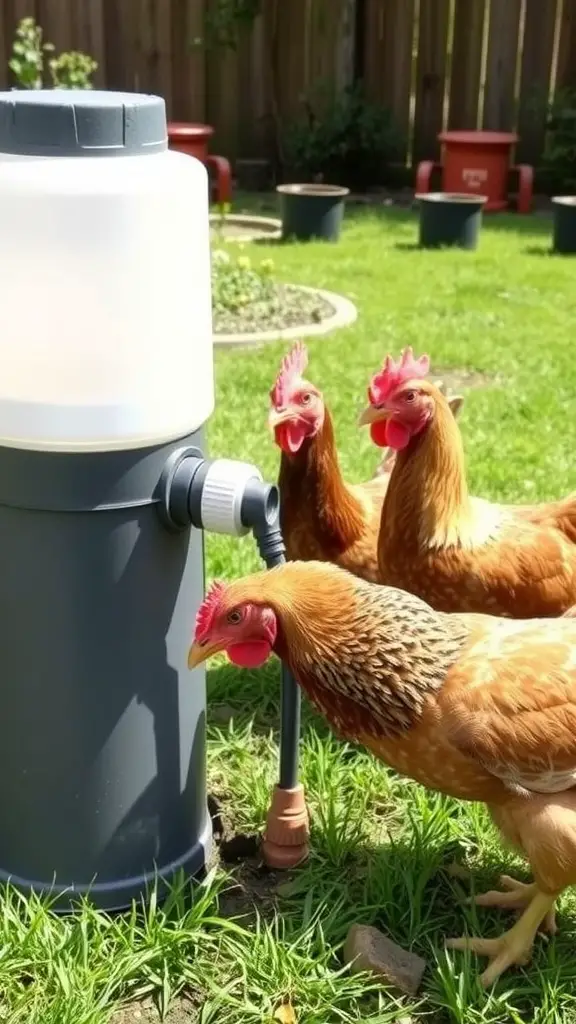
If you’re looking to keep your chickens hydrated without the hassle of frequent refills, a hose connector waterer is a solid option. This setup allows you to connect a water hose directly to your water container, ensuring a steady supply of fresh water for your flock.
In the image, you can see a simple yet effective design for a hose connector waterer. It features a sturdy container with a hose attachment. The chickens are clearly curious about their water source, which shows that they are drawn to the fresh water flowing from it.
To create your own hose connector waterer, you’ll need a few supplies: a large plastic container, a hose connector, and a water hose. You’ll attach the connector to the container, ensuring it’s sealed well to prevent leaks. Then, connect the hose to a water source. This way, your chickens will always have access to water, especially during those hot summer days.
One of the best parts of this setup is that it minimizes the amount of work you need to do. No more lugging heavy buckets of water! With a hose connector, your waterer can refill automatically, allowing you to focus on other aspects of chicken care.
Bucket with Float Valve
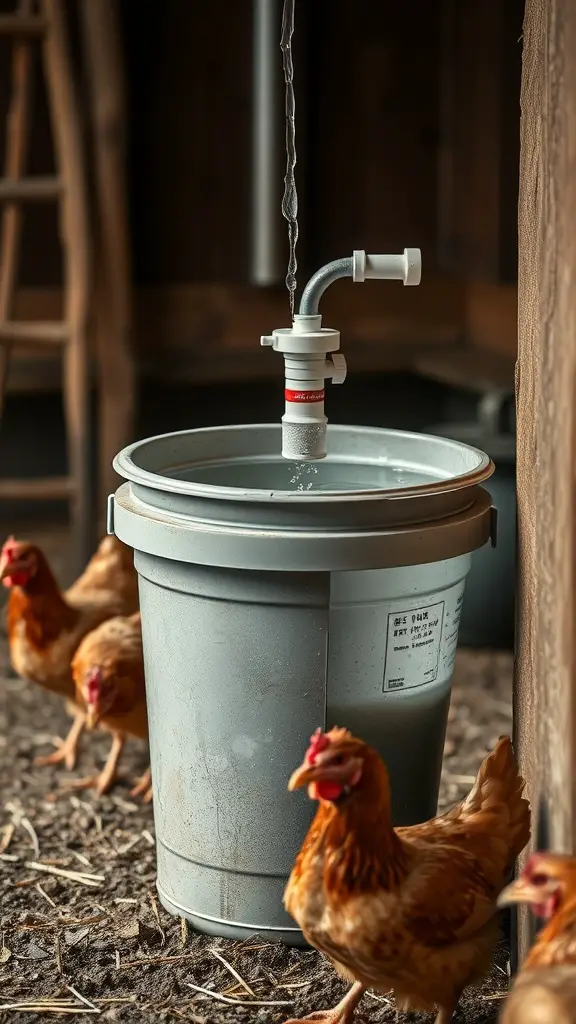
Using a bucket with a float valve is a simple and effective way to keep your chickens hydrated. This setup helps maintain a constant water level, ensuring your flock always has access to fresh water.
The float valve is the key feature here. It automatically fills the bucket as needed, so you don’t have to worry about constantly checking the water level. This can save you time and effort, especially if you have a busy schedule.
In the image, you can see a bucket with a float valve installed, ready to provide water to the chickens. The design is practical and straightforward, making it easy to assemble with just a few parts. You can even customize it based on your space and preferences.
This method not only keeps the water clean but also helps prevent spills and waste. Plus, it’s a fun DIY project that you can tackle on a weekend!

